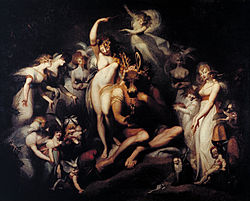Fairy painting
Fairy painting is a genre of painting and
Origins and influences

Despite its whimsical appearance, fairy painting is strongly rooted in the literary and theatrical influences of
Cultural changes were also an important factor during this period. Continuing industrialization was uprooting longstanding traditions, and rapid advances in science and technology, especially the invention of photography, left some people discomforted and confused. According to Jeremy Maas, the turn to mythological and fantasy elements, and in particular to the fairy's world, allowed an escape from these demands. "No other type of painting concentrates so many of the opposing elements of the Victorian psyche: the desire to escape the drear hardships of daily existence; the stirrings of new attitudes toward sex, stifled by religious dogma; a passion for the unseen; the birth of psychoanalysis; the latent revulsion against the exactitude of the new invention of photography."[4] The significance of fairy paintings as a reaction to cultural change is not universally accepted, however. "Ultimately," Andrew Stuttaford wrote, "these paintings were just about fun."[5]
Victorian fairy painting


The earliest artists considered to have contributed to the genre predate much of Romanticism and the Victorian era.
Fairy painting was not exclusively the domain of outside art, however. The work of
The genre also influenced the Pre-Raphaelite Brotherhood and the movement it began. Co-founder John Everett Millais produced a series of fairy paintings based on The Tempest, ending with his 1849 work Ferdinand Lured by Ariel.[10] Dante Gabriel Rossetti, another of the Brotherhood's initial members, took a more sensual approach to the subject, in both painting and poetry.[11] Others involved with the movement, such as Arthur Hughes and William Bell Scott, also contributed to the genre.
Although the Cottingley Fairies briefly revived interest in fae subjects, the waning of Romanticism and the advent of World War I reduced interest in the styles and topics popular during the Victorian era. The illustrated fairy-tale books of Arthur Rackham are considered its "final flowering".[6]
Modern revival
The interest in
References
- ^ "Victorian Fairy Painting from the Frick Collection". Antiques and the Arts Online. Archived from the original on 2007-02-04. Retrieved 2007-01-10.
- ^ Phelps, W. May; John Forbes-Robertson (1886). The Life and Life-Work of Samuel Phelps. Sampson Low, Marston, Searle & Rivington.
- ISBN 978-0-19-871176-6.
- ISBN 978-0-900946-58-5.
- ^ a b Stuttaford, Andrew (1998-12-31). "Feywatch". National Review.
- ^ a b "Fairy Painting". Tate Glossary. Tate Collection. Retrieved 2008-01-10.
- ISBN 978-0-900874-79-6.
- ^ "Etched Thoughts by the Etching Club". Blackwood's Edinburgh Magazine (346). August 1844.
- ISBN 0-691-04071-0.
- ^ Bennett, Mary (August 1984). "An Early Drawing for 'The Tempest' by Everett Millais". Burlington Magazine (126).
- ISBN 978-0-500-09316-0.)
{{cite book}}: CS1 maint: multiple names: authors list (link
